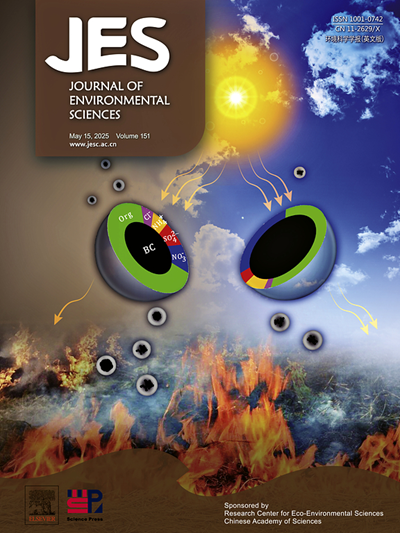Migration and morphological transformation of Mn2+ and its effect on microbial community in the A2O process
IF 5.9
2区 环境科学与生态学
Q1 ENVIRONMENTAL SCIENCES
引用次数: 0
Abstract
Manganese ion (Mn2+) was generated from metallurgical, steel making and chemical industries. It could affect microbial activity and community structure after entering sewage treatment plant. The effect of Mn2+ on the pollutant removal, metal distribution patterns and composition of microbial communities were investigated in a an anaerobic/anoxic/oxic (A2O) process. The results showed that when Mn2+ concentration was 5 mg/L, the efficiencies for the removal of chemical oxygen demand (COD), total nitrogen (TN) and total phosphorus (TP) attained remarkable levels of 96 %, 93 %, and 99 %, respectively. In the sludge, the distribution pattern of Mn2+ concentration was tightly bound extracellular polymeric substances (TB-EPS) > supernatant > loosely bound EPS (LB-EPS) > soluble microbial products (SMP). Mn2+ was found to enrich and accumulate in the microorganism cells. In addition, Mn2+ was mainly found in residual fractions and reducible fractions of pellet that manganese was present. The pellet was discovered to contain a substantial quantity of manganese, which was present in various oxidation states, including Mn4+, Mn3+ and Mn2+. The escalating levels of Mn2+ led to a reduction in the richness and diversity of microbial communities inhabiting various regions of the A2O reactor. Nonetheless, the uniformity experienced only subtle alterations. Proteobacteria and Bacteroidetes emerged as the leading phyla within the microbial ecosystem, experiencing a steady rise in their respective proportions. The dominant bacterial groups, Azospira and Dechromonas, experienced an incremental increase in their relative prevalence, which played a constructive role in the process of pollutant removal.
A2O过程中Mn2+的迁移、形态转化及其对微生物群落的影响
锰离子(Mn2+)是由冶金、炼钢和化学工业产生的。它进入污水处理厂后会影响微生物的活性和群落结构。在厌氧/缺氧/好氧(A2O)工艺中,研究了Mn2+对污染物去除、金属分布规律和微生物群落组成的影响。结果表明,当Mn2+浓度为5 mg/L时,化学需氧量(COD)、总氮(TN)和总磷(TP)的去除率分别达到96%、93%和99%。在污泥中,Mn2+浓度的分布模式是紧密结合胞外聚合物(TB-EPS) >;上层清液比;松散约束EPS (LB-EPS) >;可溶性微生物产物。发现Mn2+在微生物细胞中富集和积累。此外,Mn2+主要存在于锰存在的球团残余组分和可还原组分中。该颗粒被发现含有大量的锰,它们以各种氧化态存在,包括Mn4+, Mn3+和Mn2+。Mn2+浓度的升高导致A2O反应器各区域微生物群落丰富度和多样性的降低。尽管如此,这种一致性只经历了细微的变化。变形菌门和拟杆菌门是微生物生态系统中的主要门,它们各自的比例稳步上升。优势菌群偶氮螺旋体和脱铬单胞菌的相对流行率逐渐增加,在污染物去除过程中发挥了建设性作用。
本文章由计算机程序翻译,如有差异,请以英文原文为准。
求助全文
约1分钟内获得全文
求助全文
来源期刊

Journal of Environmental Sciences-china
环境科学-环境科学
CiteScore
13.70
自引率
0.00%
发文量
6354
审稿时长
2.6 months
期刊介绍:
The Journal of Environmental Sciences is an international journal started in 1989. The journal is devoted to publish original, peer-reviewed research papers on main aspects of environmental sciences, such as environmental chemistry, environmental biology, ecology, geosciences and environmental physics. Appropriate subjects include basic and applied research on atmospheric, terrestrial and aquatic environments, pollution control and abatement technology, conservation of natural resources, environmental health and toxicology. Announcements of international environmental science meetings and other recent information are also included.
 求助内容:
求助内容: 应助结果提醒方式:
应助结果提醒方式:


